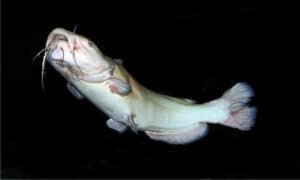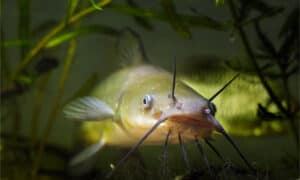Cory catfish are a group of freshwater fish belonging to the genus Corydoras. There are over 150 recognized species native to the rivers and streams of South America. Cory catfish come in many shapes, sizes, and colors, but they all share a set of behaviors and characteristics.
Cory catfish are commonly kept in aquariums as ornamental pets. They are not aggressive and are often included in large tropical community aquariums with other fish. Corys have the unique ability of being able to breathe both water and air—they often come to the surface to gather a breath.
In the wild, they are found in small, slow-moving streams and along the banks of ponds and rivers. They prefer to live in groups and often gather together into schools of hundreds or thousands of fish. While most catfish are nocturnal, corys are actually active in the daytime.
Their name originated from two Greek words: kory (helmet) and doras (skin). This is due to the defensive nature of their body—corys have tough skin and venomous spines to defend against predators. With this information in hand, let’s dive into what cory catfish eat!
The Cory Catfish Diet: What Cory Catfish Eat

Cory catfish eat a bottom-feeding diet that includes algae pellets, shrimp pellets, fish flakes, worms, and anything else that fits in their mouth. In the wild, they may consume insects, larvae, worms, plankton, and the remains of other fish.
They search for food by burying their snout into gravel and sand and sucking up food with their mouth. They use their barbels—sensory organs that look like whiskers—to detect their food.
When cory catfish eat in an aquarium, it is important to make sure enough food travels to the bottom for them. Many other fish will steal all the food before it reaches the cory catfish. If this goes unnoticed, the fish may starve and die. Cory catfish will eat shrimp pellets, algae rounds, and other nutritional pellets. Keep in mind that cory catfish are omnivores and have a wide diet, so feeding them a nutritionally varied diet is important.
What Animals Eat Cory Catfish?

in a home aquarium.
©iStock.com/Mirko_Rosenau
Cory catfish are known for their armored body and toxicity, but they can still fall prey to larger fish, birds, and other creatures. Their predators will vary wildly depending on the location of each Corydas species.
They have a few unique defense mechanisms. When a predator approaches, some species of cory catfish will play dead. They remain motionless until the predator leaves the area. Some species also have a self-poisoning mechanism, by which they release toxins as they are being attacked. While this may result in the catfish’s demise, they protect the rest of the school by engaging in this behavior.
When housed in a communal aquarium, some aggressive fish might attack or consume a cory catfish. Fish like Texas cichlids, oscars, and Jack Dempseys are known to engage in this behavior.
These aren’t the same catfish that are fried and served in the South—cory catfish are much smaller and not consumed by humans.
Which Cory Species are Popular?

The albino cory’s ghostly appearance makes it a stunning addition to any aquarium.
©SWART.0000/Shutterstock.com
There are over 150 different Corydoras species, each with different color patterns, sizes, and habitat requirements. They range in size from 1 to 5 inches in length.
Sterba’s Cory
The Sterba’s cory (Corydoras sterbai) is one of the most popular varieties, prized for its polka dot patterns and bright-orange fins. They can tolerate a wide range of water temperature and pH levels, which has led to their inclusion in many community aquariums. Their full-grown size is around 2.5 inches. Sterba’s cory requires fine gravel or sand in order to not damage their delicate barbels.
Bandit Cory
The bandit cory (Corydoras metae) is a popular species that features a black “mask” over their eyes. The species is native to the Meta River region of Columbia. They enjoy neutral pH and water temperatures in the 70s. Bandit corys (also called masked corys or Meta River corys) grow to around 1.8 inches in length. A mating pair may lay up to 100 eggs at a time, fertilizing each egg individually and then applying the sticky eggs to dense vegetation.
Pygmy Cory
The pygmy cory (Corydoras pygmaeus) is a great choice for tiny tanks that require some bottom feeders. The species is native to Peru, Ecuador, and Brazil. The pygmy cory is the smallest Corydoraas species and only grows to about 1 inch long. They have a silver body with a black stripe running horizontally.
Albino Cory
The albino cory (Corydoras aeneus) can be found at most pet shops due to its striking appearance. This variety has whitish-pink skin with red eyes and grows to around 2.5 inches in length. The species can be found all throughout South America. Their maximum size is around 2.5 inches and they can live for 10 or more years. A bronze variation of C. aeneus is also widely available.
Leopard Cory
The leopard cory (Corydoras trilineatus) is a spotted variety that enjoys living in large groups. They can handle colder water and are often housed with other coldwater fish like loaches. The leopard cory has a maximum length around 2.5 inches. The species is also referred to as the false julii corydoras or the three-line catfish.
The photo featured at the top of this post is © iStock.com/Angelo D'Amico
FAQs (Frequently Asked Questions)
Are Cory Catfish Good Aquarium Fish?
Cory catfish enjoy communal living and can be housed with six or more individuals. Be sure to provide adequate aquarium space for the amount of fish you choose to keep. Depending on the species, they can also be kept with other fish species that enjoy the same water temperature and tank conditions.
What is the Lifespan of Cory Catfish?
When properly cared for, some species of Cory catfish can live over 20 years in captivity. At least one individual was recorded as having lived over 27 years. In the wild, they usually have much shorter lifespans due to disease, predators, and human activity
Thank you for reading! Have some feedback for us? Contact the AZ Animals editorial team.






